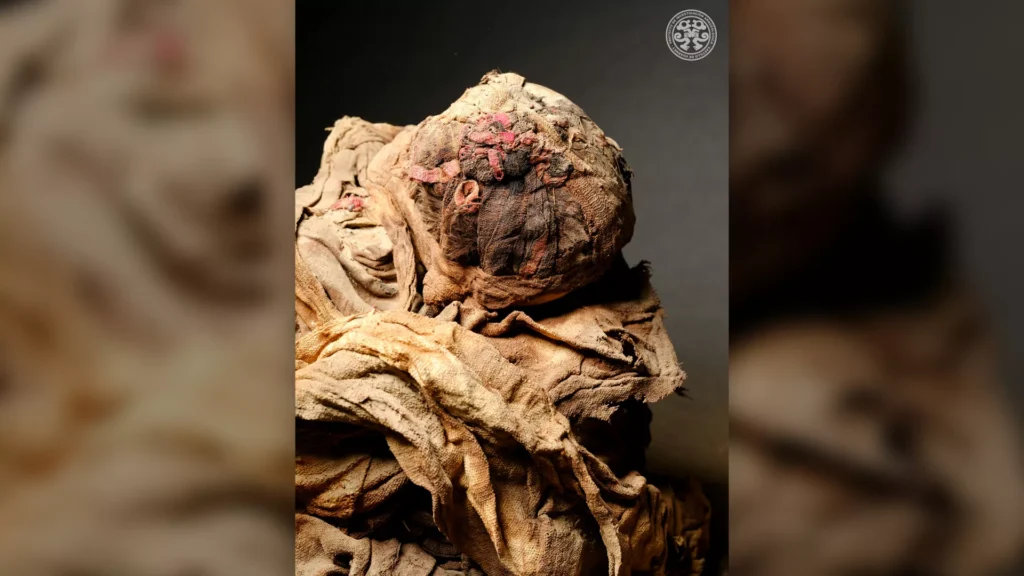Gold and silver treasures were discovered with ‘elite craftspeople’ burials near the powerful Wari queen’s tomb
Archaeologists excavating a necropolis north of Lima have unearthed a 1,300-year-old ornate tomb from the Wari era of Peru. The tomb contains the remains of a high-status man dubbed the “Lord of Huarmey.”

The remains of six other people were found in the same tomb, some of which were likely reinterred after first being buried elsewhere. The remains include four adults — possibly two males and two females — and three people who may be adolescents, according to the University of Warsaw’s Faculty of Archaeology.
All the remains in the tomb were buried with gold and silver jewellery, bronze tools, knives, axes, baskets, woven textiles, raw materials for basketry, and wood and leather items — an abundance of objects that makes archaeologists think the people buried there were skilled craftspeople, as well as members of the Wari elite.
“We could call this part of the royal necropolis ‘The Gallery of Elite Craftsmen,’” Miłosz Giersz, an archaeologist at the University of Warsaw in Poland who leads the project, told Live Science in an email. “For the first time, we have found the burials of male Wari elite, who were also fine craftsmen and artists.”
Giersz’s team discovered the latest tomb in February at the Wari necropolis near the modern coastal town of Huarmey, in the Ancash region about 155 miles (250 kilometres) north of Lima. It lies just a short distance from a larger tomb, discovered in 2012 by Giersz and his wife Patrycja Prządka-Giersz, an assistant professor at the University of Warsaw. This larger tomb contained the remains of three high-status women deemed to be “Wari queens,” as Live Science previously reported.
The queens were buried alongside the remains of 58 other people. Most of the individuals were noblewomen who may have been interred later, but some were from lower social classes and seem to have been sacrificed.

Andean empire
The Wari people lived in towns in the mountains and coast of what’s now Peru from about A.D. 500 to 1000. They are famed for their rich tradition of artwork, including gold and silver jewellery, painted pottery(opens in new tab) and vivid woven textiles.
The Wari Empire existed at roughly the same time as the Tiwanaku Empire farther south, and the two Andean states were often rivals, according to a 2003 article by archaeologists at Chicago’s Field Museum(opens in new tab). But both the Wari and the Tiwanaku empires had collapsed by the time the Inca Empire arose in much the same regions after about A.D. 1200.
The site near modern-day Huarmey features a pyramidal structure known as “El Castillo de Huarmey” — meaning the castle of Huarmey. Researchers have known about the structure since at least the 1940s, but many thought it was largely empty due to grave robbers who had already looted its gold and silver.

But the excavations in 2012 and 2013 by Giersz and Prządka-Giersz revealed it was an ancient Wari necropolis with at least one untouched tomb.
The subsequent excavation of the tomb of the Wari queens revealed that Castillo de Huarmey had once been “a large Wari mausoleum and site of ancestor worship on the Peruvian North Coast, an area that lies on the borders of the world controlled by the first Andean empire,” Giersz said.
The team also unearthed more than 1,300 artefacts that had been buried as grave gifts in the tomb of the Wari queens, including rich objects made of gold, silver, bronze, precious gems, wood, bone and shells, he said.

Wari tomb
Giersz thinks the “Lord of Huarmey” and the other people buried in the newly found tomb may have been members of the Wari elite and highly skilled craftspeople.
“The golden and silver artefacts deposited with them support this assumption,” he said. “Both men and women buried in the royal necropolis at Castillo de Huarmey were directly connected with the highest level of craft production and made the finest luxury goods of their era.”
As well as an elite necropolis, the finds show that Castillo de Huarmey was an important administrative centre of the Wari Empire, he said: “A place of production of the finest handicrafts in the domain, especially exclusive clothing… metal ornaments, and jewellery.”


Archaeologist Justin Jennings of the Royal Ontario Museum in Toronto was not involved in the latest study, but he has excavated other Wari sites in Peru.
He called the latest discoveries “spectacular,” but cautioned that the function of the Castillo de Huarmey site during the Wari era isn’t well understood. It may be that the people buried there were not elite craftspeople, as Giersz has proposed.
“These are wonderful pieces, and it’s so nice to have these associated with the graves,” Jennings said. But “the dead don’t get to choose what goes into their tombs — their grave goods can reflect what they did in life, but they could also very much reflect other types of messages.”
He noted, however, that the upper classes of ancient American societies were often also elite craftspeople, most famously the later Maya in Mesoamerica. “The Maya elite spent a lot of their time making elite goods, so it’s certainly not out of the ordinary,” Jennings said.
The inclusion in the grave goods of unfinished objects was also notable, he said. “I think that does lend some credence to the idea that some of these individuals were involved in the production of things.”





